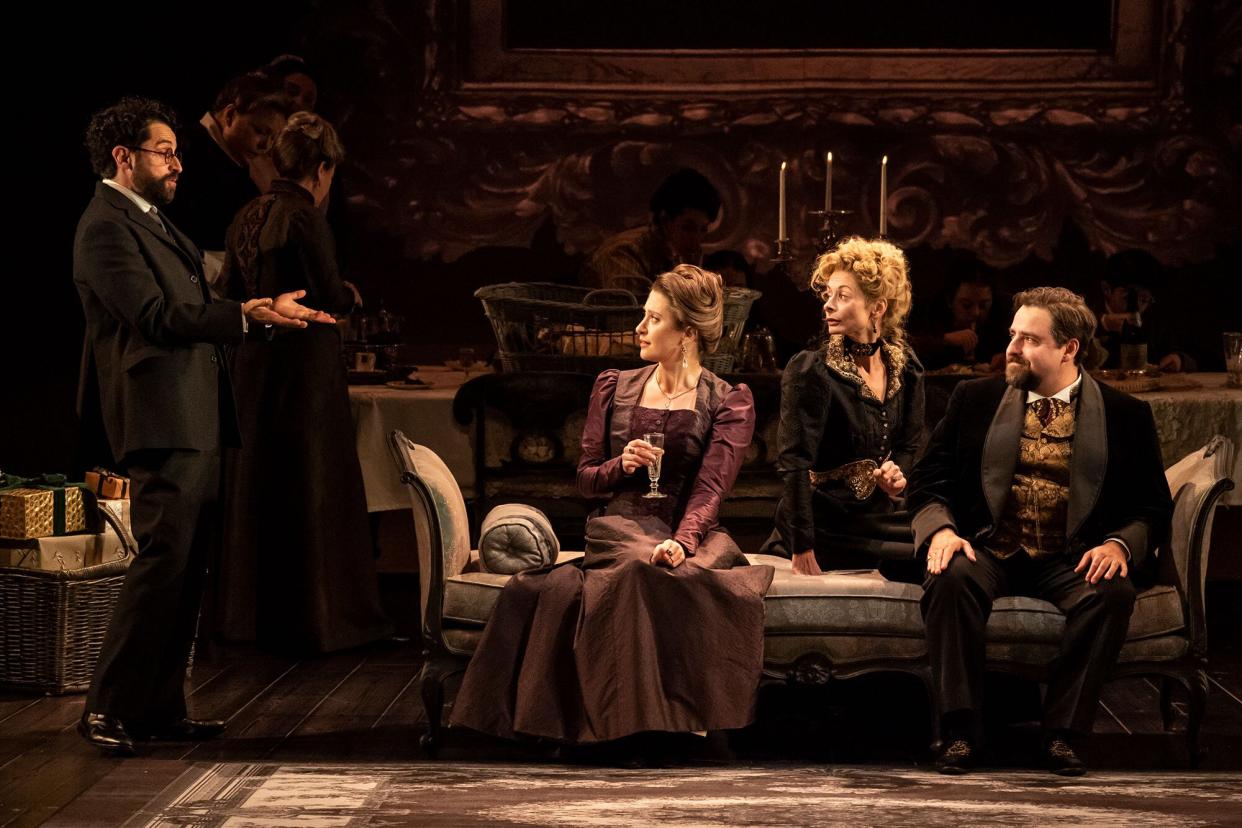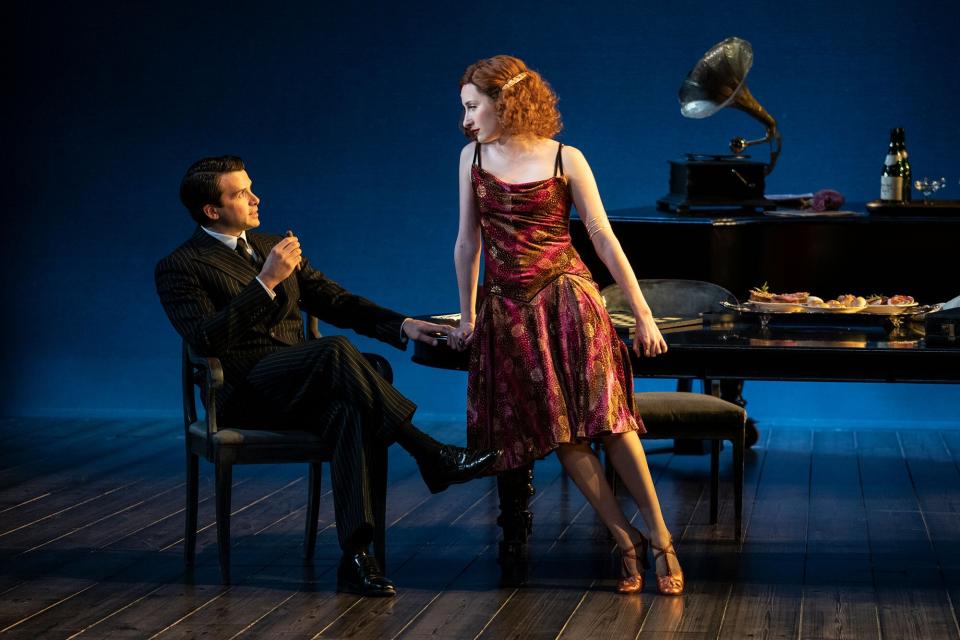Leopoldstadt review: Tom Stoppard's latest play is a moving, humane tale of the Holocaust

- Oops!Something went wrong.Please try again later.
The Holocaust sometimes seems like an overly-familiar topic. It is, after all, already the subject of some of the most famous books and films in the world, not to mention any history class worth its salt. But perhaps one result of this exposure is that it's easy to overestimate one's understanding of the Holocaust. The power and urgency of Leopoldstadt, Tom Stoppard's newest (and possibly final) play, is how it reminds us both of the Holocaust's eternal relevance, and the true depth of the loss that humankind suffered. That comes both from the breadth and depth of the cast, which spans more than 30 characters across several time periods, and the creative ways that the Broadway production (directed by Patrick Marber) shows the passage of time.
As in many of his past works, Stoppard excels at demonstrating that grand historical narratives are not at all evident to the people who have to live through them. Arcadia showed modern-day characters trying to understand the past, while flashback scenes showed how wrong their assumptions were. In another of his most famous plays, Stoppard showed how Rosencrantz and Guildenstern have no idea that they're in the middle of Hamlet. So when the modern theatergoer sits down for Leopoldstadt and reads that it will be a multi-generational epic following an Eastern European Jewish family through the first half of the 20th century, we know that it will inevitably be a story about the Holocaust. But the characters don't know that — and why would they? After all, turn-of-the-century Vienna seemed like the pinnacle of multicultural acceptance.

Joan Marcus The cast of 'Leopoldstadt' on Broadway
That's where Leopoldstadt begins: A Viennese drawing-room in 1899, where a big Jewish family is celebrating the winter holidays. Those decorations include a massive Christmas tree, because the family is interspersed with interfaith marriages. Some of these pairings are for love, but others are because in spite of its polyglot reputation, the aristocracy of the Austro-Hungarian Empire was decidedly Catholic. Hermann Merz is a wealthy factory owner, but he knows he will never be fully accepted by the Viennese ruling class if he identifies as Jewish. His self-hatred turns into an abiding faith in what he sees as the liberal, melting-pot nature of turn-of-the-century Vienna.
"We are the torchbearers of assimilation," Hermann confidently tells his brother-in-law Ludwig, a mathematics professor who in turn points out the Austro-Hungarian authorities seem perfectly happy to stand by and watch his Jewish students get assaulted in the street. The discussion veers from aggressively political to drunkenly apologetic (the kind of conversation we've all experienced with family members at holiday gatherings), but overall it's just a treat to see actors like David Krumholtz and Brendan Uranowitz feast on Stoppard's dialogue. Even when multiple characters are on stage having overlapping conversations, the writing and performances still sparkle.
This debate between Hermann and Ludwig is where the play's title first comes in. "Leopoldstadt" was the name of the former Jewish ghetto in Vienna, a social arrangement that Hermann thinks has been banished to the dustbin of history alongside the many "expulsions, massacres, burnings, blood libels…pogroms, ghettos, yellow patches" that European Jews had to endure for so many centuries. Since this is a play about the Holocaust, we know that Hermann is tragically wrong…but his attitude provokes us to wonder if we aren't falling into the same trap of seeing the Holocaust as a past event whose depravity can never again be approached. It's nice to think that history moves in a progressive direction, but it's really just one thing after another, and sadly there is no cosmic law that prevents horrors from recurring.

Joan Marcus Japhet Balaban and Eden Epstein in 'Leopoldstadt'
Time keeps moving, and so does Leopoldstadt: First just some years ahead to 1900, then all the way to 1924, when the family has been ravaged by World War I: Hermann's son Jacob is now missing an eye and an arm after his time on those meat-grinder battlefields, while Ludwig's son Poldi is just plain dead. But even amidst the devastation, there is hope. Jacob's cousin Nellie is now dating a socialist organizer and happily knitting a red flag as she talks about how the workers of the world are bound to unite.
That hope is gone by the time the play moves forward again, to 1938 — the year of Anschluss and Kristallnacht. Worker uprisings have been defeated, and Nazism is ascendant in Europe, but this family can't even imagine escaping the only home they've ever known (every scene takes place in the same room, which visualizes the passage of time and makes it easier to chart how the characters endure the accompanying changes). All but Nellie, that is. Even with her political dreams crushed, Nellie is looking forward, and has remarried to a British journalist who promises to spirit her and her young son Leopold (another reflection of the title, and the history of oppression it represents) to safety.
This, as you may or may not know, is a reflection of Stoppard's own life story. He, too, was a young European Jewish boy in the '30s (though in Czechoslovakia, not Austria) who was saved from the Holocaust by his mother's marriage to a British officer while many of his family members perished in the Nazi camps. It's worth thinking about how this one human being, spared from the worst by a chance of fate, went on to write some of the most acclaimed English-language plays and films of the last half-century. How many other works of art or mathematical breakthroughs were lost when the people who might have created them were killed simply because of who they were or where they were born?
The image on the Leopoldstadt playbill is of a young Jewish child playing with a cat's cradle. This motif shows up in the play itself in the 1938 sequence: After the Nazis have robbed Jewish Austrians of their most valuable possessions, all the children have left to play with are pieces of string. But that string can still be made into something perfect: As Ludwig lovingly points out to his grand-nephews, the knots in the cat's cradle always stay the same distance apart no matter how the configuration is manipulated. For Ludwig, this is proof of the mathematical order that underlies the tragic chaos of the universe. For the rest of us, it's a powerful reminder of importance of every single life, as well as the human capacity to salvage beauty out of disaster. B+
Related content:

